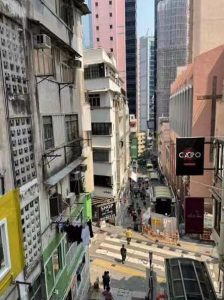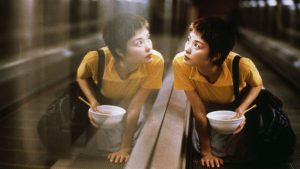Chungking Express released in 1994 is a romantic comedy-drama film written and directed by Wong Ka Wai. The film is composed of two intersecting stories, telling how two frustrated men and women can free themselves from their past love and start a new life. Under the typical Wong Ka Wai style lens, the Mid-levels Central Escalator plays a critical role in telling the story of Faye and the No. 663 police officer. 663, his stewardess girlfriend, and Faye also took this escalator up and down in the film. In Chungking Express, Faye peeped through the glass of 663, who was riding on the escalator. The secret love affairs on her face are still one of the most classic scenes. In other words, the escalator is an essential object in the film to make the couple connected.
Mid-levels Central Escalator starts from Central to Mid-levels, wounding approximately 800 meters, which is the main route that connects these two areas. Lying in the most prosperous and crowded places, Mid-level Central Escalator observes the daily life of Hong Kong: Hurried white collars, foreigners chatting on the roadside and coffee shops enjoying the sunlight, and tourists with maps and cameras. Most of the time in the film, the elevator is presented from the perspective of the house next to it with Faye’s favorite music California Dreaming playing. Stepping on the escalator, you are not only an observer but also the scenery of this city. Just as the film’s lines say: Every day, you have the opportunity to pass by others. You may know nothing about him, but maybe one day he will become your friend or confidant… Mid-levels Central Elevator is very close to the narrow buildings next to it. Flows of advertisement billboard pass by. Occasionally, you can see that layout inside the shops. From the downtown to the top of the mountain, from the noisy commercial district to the quiet residential area sitting in the mid-levels, the escalators connect Hong Kong’s different sides.
In Chungking Express, though the focus of these two stories presented is different, they portray the same emotional states of urbanites: lost and lonely. People live in places with extremely high population density and are very close, but everyone lives in their lonely world. In the film, the four characteristics have accidentally encountered each other; however, they have no awareness of others’ existence. The fast-moving escalator exactly symbolizes the fast pace of Hong Kong, which also connects with fast-speed love. Although the film holds a doubt to this kind of love, it also expresses the expectation for pure love. Faye fell in love with 663, who took the escalator to get off work every day. She often hid in the curtain to peek or jumped on the escalator and looked around, overlooking the world he oversees and feeling what he feels. What can be seen from the small window is limited. It implies that a girl is falling in love with an eye concentrated merely on 663. Her crush is almost crazy for no reason. In reality, no one may dare to be so bold, but it is straightforward in the film. The contrast between the fast-speed life of the people outside and the pure love of Faye inside is touching.


upper: a photo taken at the start of that Mid-level Central Escalator
below: looking away from the escalator


upper:Faya on the escalator
below: looking out of 663’s apartment is the Mid-level Central Escalator
Fu Shitong,3035772585
I enjoy reading your comparative analysis of the movie and your insights; interweaving your knowledge of the escalator, observations, and the scene descriptions together. I appreciate that you noted the escalator was seen from different perspectives in the movie which you’ve also tried to show with your own documentation. It would greatly benefit if there are more visual materials on the spaces that the escalator connects to in order to show the significance of this piece of infrastructure. Yoos and James’ The Multilevel Metropolis from L5 might also be helpful in supporting your thoughts.